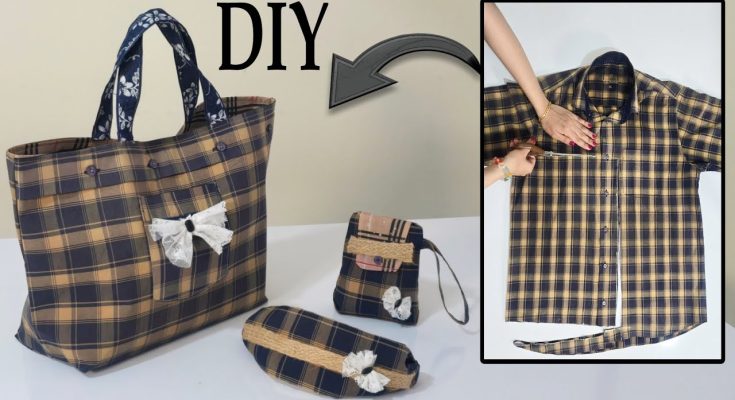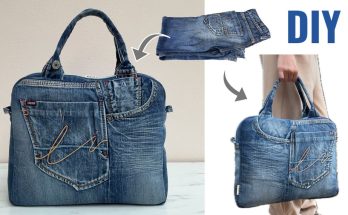You’re ready to give that old shirt a fantastic new life as a tote bag – that’s a wonderful way to upcycle and create something unique and personal! Transforming a shirt, especially a large T-shirt or a sturdy woven button-up, into a tote is a fun and rewarding project.
This guide will walk you through creating a functional and stylish tote bag from an old shirt. We’ll cover the essential steps, from preparing your shirt to finishing your new bag.
How to Sew a Tote Bag from an Upcycled Shirt
I. Planning Your Upcycled Tote
Before you pick up your scissors, a bit of planning will help you get the best results from your old shirt.
- Choose Your Shirt Wisely:
- Large Adult T-shirt (XL, XXL): Ideal for a soft, casual, and often graphic-rich tote. The knit fabric is forgiving with raw edges, making it a good choice for beginners.
- Sturdy Woven Shirt (Denim, Flannel, Cotton Button-Up): Provides more structure and durability, resulting in a sturdier tote. A men’s large or XL shirt will offer more usable fabric. You can often reuse existing pockets or even button plackets.
- Condition: Make sure the shirt is clean, free of major stains (unless you want that distressed look!), and ironed.
- Desired Tote Size: How big do you want your finished tote to be?
- Small (e.g., 10″ x 12″): Great for a lunch bag or small project. Easily achievable from most large shirts.
- Medium (e.g., 14″ x 15″): Versatile for everyday use, books, or light groceries. Possible from larger shirts (XL/XXL).
- Large (e.g., 16″ x 18″): Roomy carry-all. Might require piecing fabric from two shirts or using a very large shirt.
- Key Features You Want:
- Lining: Highly recommended for durability, a cleaner finish, and often includes an interior pocket. You’ll likely need new fabric for this.
- Pockets: Do you want to reuse an existing shirt pocket on the outside of your tote, or add a new one on the inside?
- Handles: Will you make new fabric handles from the shirt scraps or another fabric, or use webbing?
- Shirt Graphics/Details: If your shirt has a cool graphic or unique stitching, plan your cuts to feature it prominently on your tote!
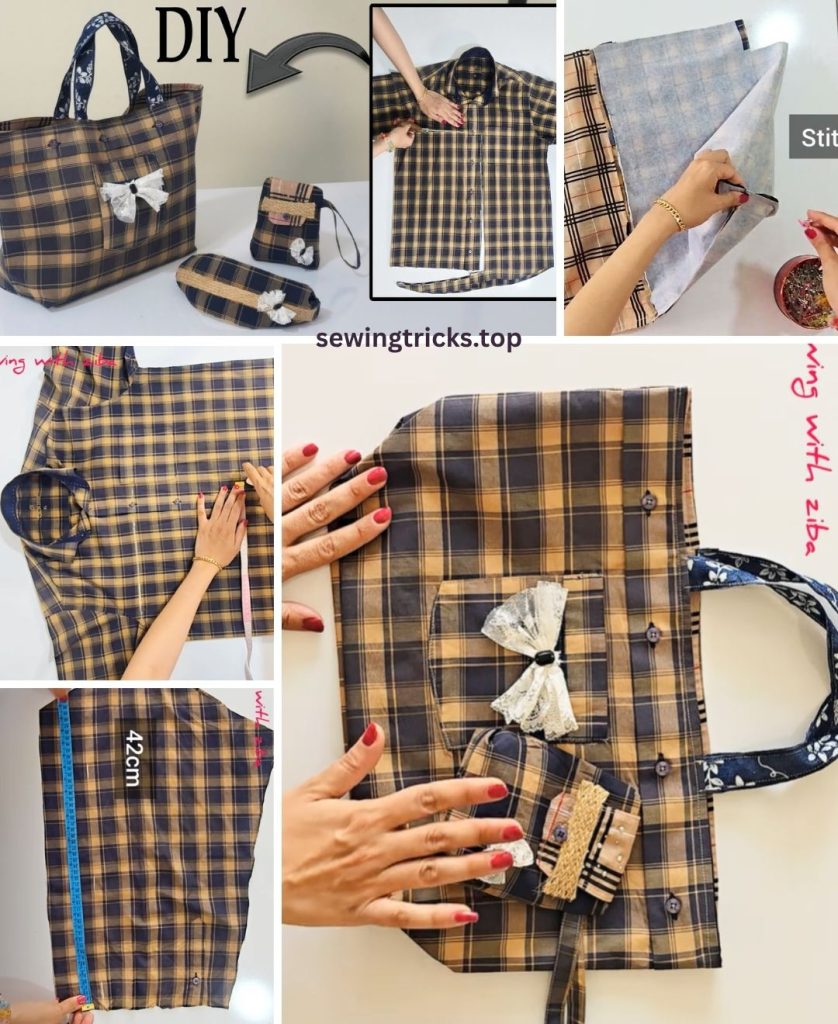
II. Gather Your Materials
Having everything ready before you start sewing will make the process much smoother.
- Your Upcycling Material: 1 large, clean, and ironed old shirt.
- Lining Fabric: 1 to 1.5 yards (0.9 to 1.4 meters) of medium-weight quilting cotton, broadcloth, or poly-cotton. Choose a color or print that complements your shirt’s fabric.
- Matching Thread: All-purpose polyester thread. For denim or canvas shirts, consider a heavy-duty thread and a longer stitch length for topstitching.
- Stabilizer (Optional but Recommended for Structure): If you want a more structured tote that stands on its own (especially important for T-shirt fabric), get 1 to 1.5 yards (0.9 to 1.4 meters) of fusible fleece (like Pellon 987F) or heavyweight fusible interfacing (like Pellon 809 Decor Bond).
- Handle Material:
- Fabric Handles: An additional 1/2 yard (0.45 meters) of sturdy fabric (can be from shirt scraps if enough, or new coordinating fabric).
- Webbing Handles: 1.5 to 2 yards (1.4 to 1.8 meters) of 1-inch or 1.5-inch wide cotton or polyester webbing.
- Basic Sewing Supplies:
- Sewing Machine (with a walking foot if sewing thick fabrics like denim or multiple layers).
- Correct Needles: A universal needle for most cotton shirts; a ballpoint or stretch needle for T-shirts; a denim/heavy-duty needle (90/14 or 100/16) for denim shirts.
- Sharp Fabric Scissors or Rotary Cutter and Mat.
- Long Quilting Ruler or Measuring Tape.
- Fabric Chalk or Mark-B-Gone Pen.
- Plenty of Pins or Fabric Clips (clips are great for holding thicker layers!).
- Iron and Ironing Board (essential for fusing interfacing and crisp seams).
- Seam Ripper (your best friend for deconstruction!).
III. Prepare Your Shirt & Cut Fabric Pieces
This is the most strategic part! You’ll be maximizing the usable fabric from your shirt.
A. Deconstruct Your Shirt:
- Lay the shirt flat and smooth it out perfectly.
- Cut off the sleeves.
- For T-shirts: Cut straight across the shirt, just below the armpits, to remove the top portion (neck, shoulders). You’ll be left with a large rectangle (or slightly tapered shape) that includes the original bottom hem. This original hem can become the top opening of your tote bag, or you can cut it off if you prefer a new hem.
- For Woven Shirts (button-up, denim): Carefully use your seam ripper to open up the side seams and shoulder seams to get large, flat panels of fabric. This gives you the most usable material.
- Salvage Pockets: Carefully cut out any existing shirt pockets (like breast pockets or back pockets on a denim shirt) if you want to reuse them on your tote.
B. Determine Your Panel Sizes (Example: Medium Tote – 14″ W x 15″ H x 4″ D):
We’ll use a 1/2-inch (1.27 cm) seam allowance throughout.
- Main Body Panel Width: Finished Width + Finished Depth + (2 * Seam Allowance) = 14″ + 4″ + 1″ = 19 inches (48.3 cm)
- Main Body Panel Height: Finished Height + Finished Depth + (2 * Seam Allowance) = 15″ + 4″ + 1″ = 20 inches (50.8 cm)
C. Cut Your Fabric Pieces:
- Exterior Bag Pieces (from your shirt):
- Main Body: Cut 2 rectangles, each 19 inches wide x 20 inches high. You will likely need to piece smaller salvaged fabric sections together to get these large panels.
- Tips for Piecing Upcycled Fabric:
- Lay out your opened shirt pieces. Arrange them to maximize cuts.
- Place two shirt pieces right sides together, aligning a raw edge. Stitch them with a 1/2-inch seam allowance.
- Press the seam open thoroughly to reduce bulk.
- Topstitch (Highly Recommended for woven shirts): On the right side, sew two lines of stitching, one on each side of the seam line (about 1/8 inch / 0.3 cm away). This adds strength and a nice detail.
- Continue piecing until you have large enough panels.
- Tips for Piecing Upcycled Fabric:
- Main Body: Cut 2 rectangles, each 19 inches wide x 20 inches high. You will likely need to piece smaller salvaged fabric sections together to get these large panels.
- Lining Fabric Pieces:
- Main Body: Cut 2 rectangles, each 19 inches wide x 20 inches high.
- Interior Slip Pocket (Optional): Cut 1 rectangle, 10 inches wide x 12 inches high.
- Stabilizer (Optional):
- Main Body: Cut 2 rectangles, each 18 inches wide x 19 inches high (1 inch smaller on all sides than your main panels).
- Handle Material:
- New Fabric Handles: If making, cut 2 rectangles, each 4 inches wide x 25 inches long. (Can be from sturdy shirt scraps if available).
- Webbing Handles: If using, cut 2 lengths, each 18-25 inches (46-63.5 cm) long (total 36-50 inches / 91.5-127 cm).
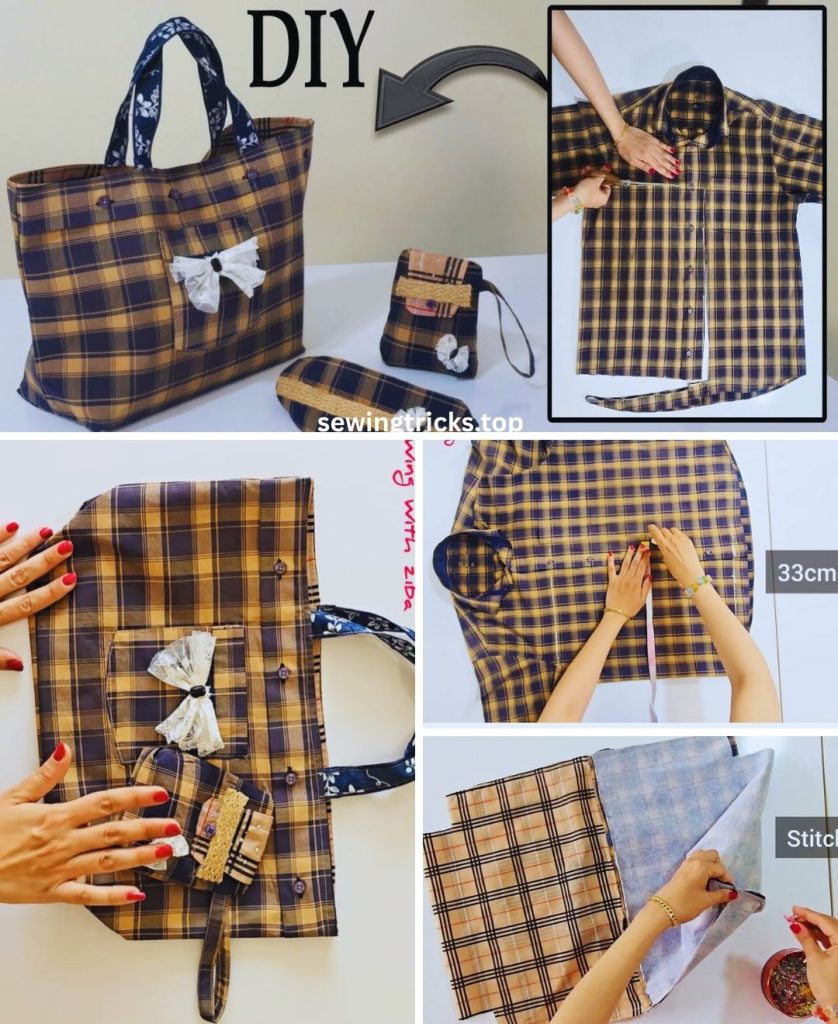
IV. Let’s Start Sewing Your Upcycled Tote Bag!
General Sewing Tips for Upcycling:
- Press, Press, Press: Essential for removing old creases and getting accurate cuts and flat seams.
- Needle Choice is Crucial: Use the right needle for your shirt fabric (ballpoint for knits, denim for denim, universal for most wovens).
- Go Slow Over Bulk: If your shirt fabric has existing seams (like a denim shirt) or you’ve pieced sections, go slowly with your machine. Use a hump jumper (a small piece of folded fabric) if your presser foot struggles over thick spots.
- Wonder Clips are Your Friends: They hold thick layers much better than pins.
- Embrace the Unique: Part of the charm of upcycling is the unique character your bag will have. Don’t stress over minor imperfections.
Step 1: Prepare Exterior Panels (Fuse Stabilizer & Add Optional Pockets)
- Fuse Stabilizer (Optional): Take your two Exterior Fabric Main Body Panels. Lay each wrong side up on your ironing board. Center and fuse the corresponding Stabilizer piece to each. This gives your tote structure and helps it stand upright.
- Add Exterior Pockets (Optional): If you salvaged a shirt pocket (e.g., a breast pocket or a back pocket from a denim shirt), topstitch it onto one Exterior Fabric Main Body Panel now (this will be the front of your bag), before sewing the panels together. Position it creatively!
Step 2: Construct the Exterior Bag Body
Use a 1/2-inch (1.27 cm) seam allowance.
- Place the two Exterior Fabric Main Body Panels right sides together, carefully aligning all raw edges.
- Clip securely along both side edges and the entire bottom edge. Leave the top edge open.
- Stitch from one top corner down that side, pivot sharply at the bottom corner, stitch straight across the bottom, pivot again, and stitch up the other side to the top corner. Backstitch at the beginning and end of your seam.
- Press your seams open thoroughly to reduce bulk. (For knit T-shirt fabric, you can press to one side to minimize bulk if preferred).
Step 3: Box the Corners of the Exterior Bag
This step creates the flat, defined bottom of your tote bag.
- Lay the exterior bag body flat. At one of the bottom corners, carefully bring the side seam and the bottom seam together, aligning them perfectly. This action will naturally form a triangular shape at the corner.
- Measure from the tip of this triangle inward along the seam line a distance equal to half of your desired bag depth (e.g., for a 4-inch deep bag, you’ll measure 2 inches / 5 cm).
- Draw a straight line perpendicular to the seam at this measured point. This is your new stitching line.
- Clip firmly along this drawn line.
- Stitch precisely along the drawn line, backstitching securely at both ends.
- Trim the excess fabric from the corner, leaving about a 1/2-inch (1.27 cm) seam allowance beyond your new stitching line.
- Repeat this exact process for the other bottom corner of your exterior bag body.
- Result: Your exterior bag now has a structured, flat bottom. Keep it wrong side out.
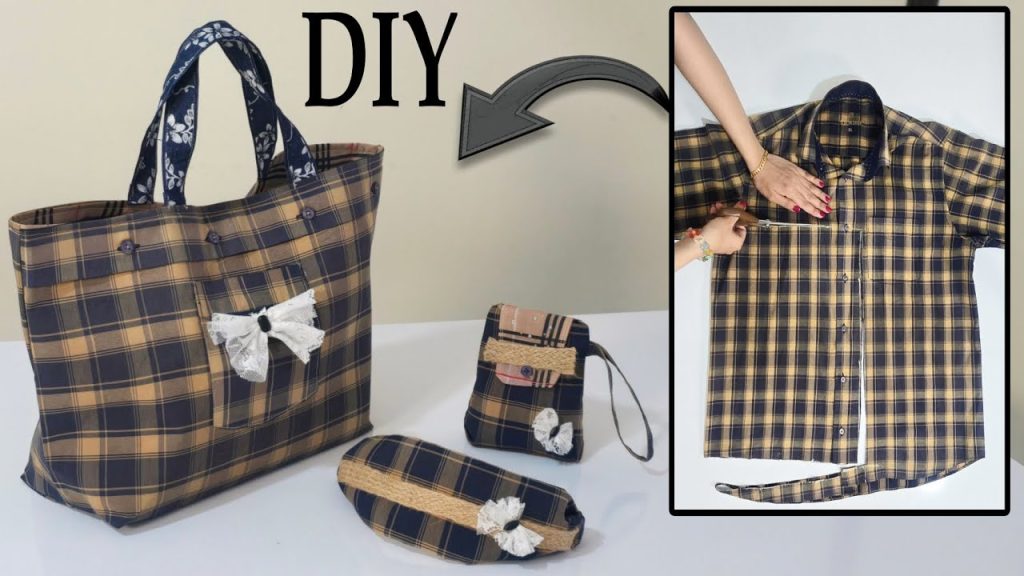
Step 4: Sew the Lining Bag Body (with Optional Pocket)
The lining is constructed almost identically to the main bag, with one crucial difference for turning the bag right side out.
- Prepare Interior Slip Pocket (Optional):
- Take your 10″ x 12″ pocket piece. Fold it in half, right sides together, so it’s 10″ x 6″. Stitch around three sides (the two long sides and one short side), leaving a 3-4 inch (7.6-10.2 cm) opening on the remaining short side (this will be the bottom of the pocket). Trim corners.
- Turn the pocket right side out through the opening. Push out corners neatly and press flat. Stitch the opening closed by machine (very close to the edge) or by hand using an invisible ladder stitch.
- Position and Attach Pocket: Take one of your Lining Fabric Main Body Panels. Position the pocket about 4-5 inches (10-12.7 cm) down from the top raw edge, and centered horizontally.
- Topstitch the pocket to the lining panel along its two sides and bottom edge. Stitch close to the edge. Reinforce the top corners of the pocket with a small triangle stitch or a few back-and-forth stitches, as these are high-stress points.
- Sew Lining Body:
- Place the two Lining Fabric Main Body Panels right sides together, aligning all raw edges.
- Clip or pin along both side edges.
- CRUCIAL STEP: For the bottom seam, you must leave an opening! Stitch down one side seam. Then, for the bottom seam, stitch approximately 3 inches (7.6 cm) from one side, then leave a 4-6 inch (10-15 cm) unstitched gap in the middle of the bottom seam. This opening is absolutely essential for turning the entire bag right side out later. After the gap, stitch for another 3 inches (7.6 cm) to reach the other side seam. Backstitch well at the start and end of the stitched sections around your opening.
- Stitch up the second side seam.
- Press your seams open.
- Box the Corners of the Lining Bag: Box the corners of your lining bag using the exact same method you used for the exterior bag (refer back to Step 3).
- Result: Your lining bag is now fully constructed, with that important turning opening. Keep it wrong side out.
Step 5: Prepare and Attach Handles
A. If Using Fabric Handles (New Fabric or Upcycled Fabric Strips from shirt):
- Take one handle strip (4″ x 25″). Fold it in half lengthwise, wrong sides together, and press firmly. Open it up.
- Fold each long raw edge in towards the center crease you just made, and press again.
- Fold the entire strip in half again along the original center crease. You should now have a long, flat handle that is about 1 inch (2.5 cm) wide with no raw edges visible. Press firmly along the entire length.
- Topstitch down both long sides of the prepared handle, about 1/8 inch (0.3 cm) from the edge. This secures all the folds and makes a neat, strong handle.
- Repeat this process for the second handle strip.
- Attach to Exterior Bag: Turn your exterior bag right side out. Lay it flat, smoothing it out.
- Measure in from each side seam along the top raw edge by about 4-5 inches (10-12.7 cm). Mark these points with chalk.
- Position the raw ends of one prepared handle on the top raw edge of the bag at your marks. Make sure the handle itself is flat and not twisted. Pin securely.
- Stitch the handle ends in place. For a strong hold, sew a small square (about 1×1 inch) with an “X” inside it (an X-box stitch) for maximum reinforcement. Stitch within the 1/2-inch (1.27 cm) seam allowance, close to the raw edge.
- Repeat for the other side of the bag with the second handle.
B. If Using Webbing Handles (New or Salvaged from another bag):
- Cut your webbing into two equal lengths (e.g., two 18-20 inch / 46-51 cm pieces).
- Attach to Exterior Bag: Turn your exterior bag right side out. Lay it flat.
- Measure in from each side seam along the top raw edge by about 4-5 inches (10-12.7 cm). Mark these points.
- Position one raw end of the webbing on the top raw edge of the bag at one mark, with the webbing loop pointing down into the bag. Pin securely.
- Stitch the webbing end in place using an X-box stitch. Stitch within the 1/2-inch (1.27 cm) seam allowance. Repeat for all four webbing ends (two ends per handle).
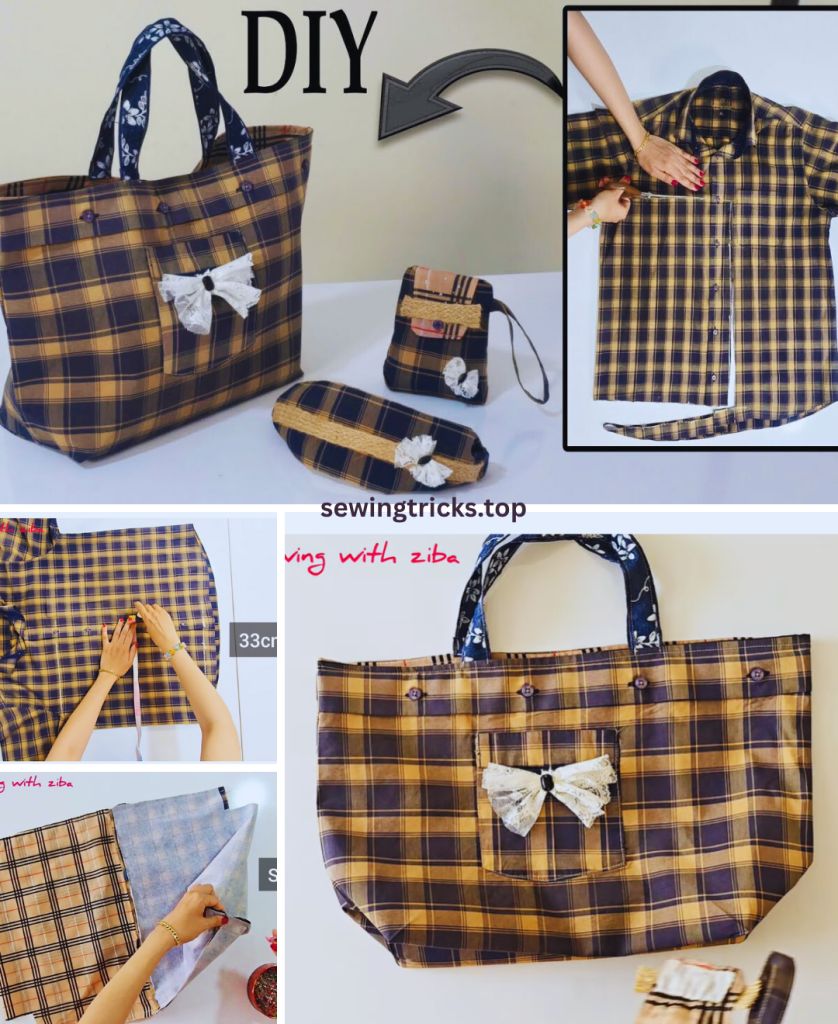
Step 6: Join the Exterior Bag and the Lining Bag (The “Bag-in-a-Bag” Method)
This clever technique encloses all raw edges at the top for a super clean and professional finish.
- Ensure your exterior bag is right side out, with handles attached and pointing down into the bag.
- Ensure your lining bag is wrong side out (and still has that turning opening at the bottom).
- Carefully insert the exterior baginto the lining bag.
- The right sides of both bags should now be facing each other.
- Align the side seams of the exterior bag with the side seams of the lining bag.
- Align the top raw edges of the exterior fabric and the lining fabric all around the entire opening of the bag. The handles should be sandwiched between the layers, pointing down.
- Clip very securely all the way around this top edge, matching up seams precisely.
- Using your 1/2-inch (1.27 cm) seam allowance, stitch all the way around the entire top opening of the bag. Go slowly and carefully, especially when you go over the handle attachment points (which will be thick!). Backstitch at the beginning and end of your seam.
- Trim Bulk: Carefully trim the seam allowance at the top down to about 1/4 inch (0.6 cm) to reduce bulk inside the top edge.
Step 7: Turn Your Bag Right Side Out & Finish
This is the incredibly satisfying moment your upcycled tote bag takes its final, beautiful shape!
- Reach through the opening you left in the bottom seam of the lining.
- Slowly and carefully pull the entire bag (exterior, lining, handles – everything!) through this opening until it is completely right side out. Take your time, gently pushing out all the corners for a crisp, well-defined shape.
- Close the Lining Opening: Go to your ironing board. Press the raw edges of the opening in the bottom of the lining under by 1/2 inch (1.27 cm) so they meet neatly. Align these pressed edges and clip them together. Stitch this opening closed by machine (sewing very close to the folded edge for a neat finish) or by hand using an invisible ladder stitch for a truly seamless look.
- Now, push the lining down into the exterior bag.
- Final Press & Topstitch: Carefully press the entire top edge of the bag. Make sure the lining is fully tucked inside and isn’t peeking out over the top edge of the exterior fabric.
- For a super polished and durable finish, topstitch all around the entire top opening of the bag, about 1/8 inch (0.3 cm) from the edge. This final topstitching marries the lining to the exterior, helps the bag hold its shape, and creates a crisp, professional look. You can also sew a second row of topstitching about 1/2 inch (1.27 cm) from the top edge for added detail and stability.
Your unique, upcycled tote bag is now complete! You’ve given new life to an old shirt and created a functional, durable, and stylish accessory that’s truly one-of-a-kind. Enjoy carrying your sustainable creation!
What’s next on your sewing project list?

